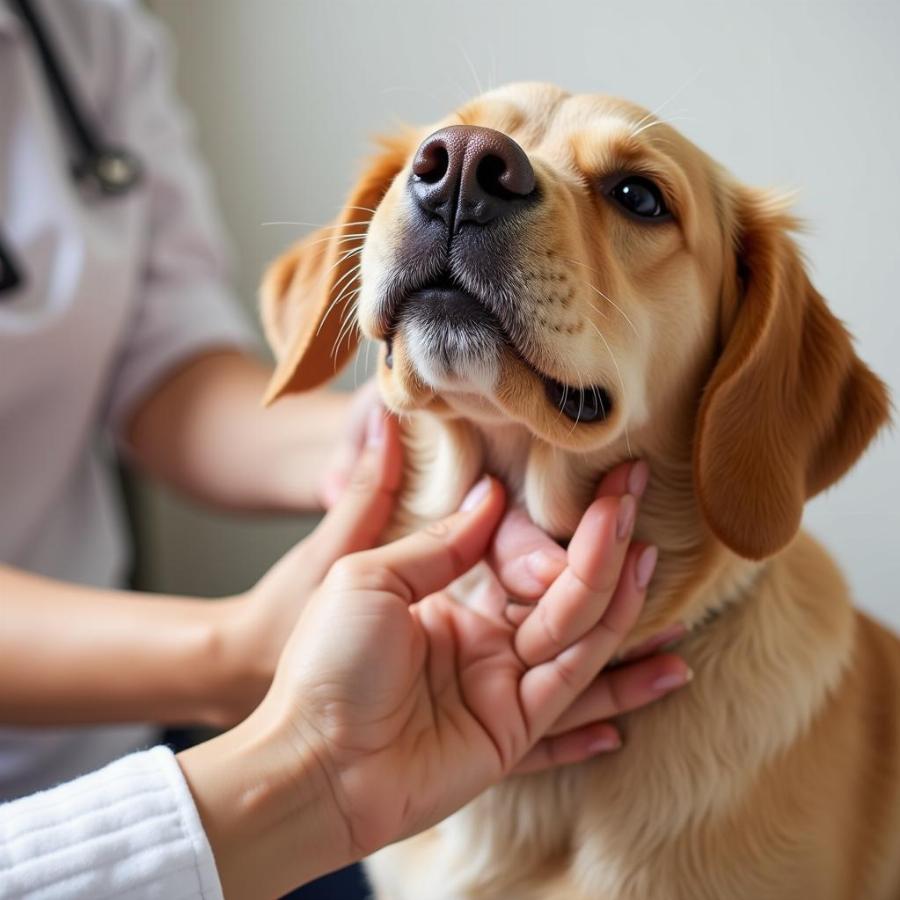As a caring dog owner, you’re probably aware of the importance of your furry friend’s health. Just like in humans, lymph nodes play a crucial role in a dog’s immune system. Understanding where these nodes are located and why they’re important can be incredibly helpful, especially when it comes to early detection of potential health issues.
What are Lymph Nodes and Why are They Important?
Lymph nodes are small, bean-shaped organs that are part of the lymphatic system, a complex network of vessels and tissues that help the body fight off infection and disease. Think of them as tiny but mighty warriors strategically stationed throughout your dog’s body. They filter lymph fluid, trapping harmful substances like bacteria, viruses, and even cancer cells.
When your dog’s immune system is fighting something off, the lymph nodes near the affected area can become enlarged as they work overtime to combat the threat. This swelling is a normal immune response and usually subsides once the infection or inflammation clears up.
Where are Lymph Nodes Located in Dogs?
While dogs have numerous lymph nodes throughout their bodies, some are more easily felt than others. These palpable lymph nodes are typically located in areas where the lymphatic vessels are concentrated. Being familiar with their location can help you monitor your dog’s health:
- Submandibular Lymph Nodes: Located under the jaw, on either side of the windpipe. These are usually the easiest to find and often the first to swell if there’s an infection in the mouth, throat, or teeth.
- Prescapular Lymph Nodes: Found just in front of the shoulder blades. Enlargement here could indicate an issue in the chest, front legs, or upper body.
- Axillary Lymph Nodes: Situated in the armpit region. Swelling may be associated with infections or tumors in the legs, chest, or mammary glands.
- Inguinal Lymph Nodes: Located in the groin area, where the back legs meet the body. Enlargement can occur with infections or injuries to the hind legs, lower abdomen, or reproductive organs.
- Popliteal Lymph Nodes: Found behind the knee joint. Swelling here may indicate a problem with the lower leg or foot.
When to See a Vet
While it’s normal for lymph nodes to be slightly movable under the skin, they should not be hard, fixed in place, or causing your dog any discomfort.
If you notice any of the following, it’s essential to schedule an appointment with your veterinarian as soon as possible:
- Sudden or persistent swelling of one or more lymph nodes
- Lymph nodes that are hard, immobile, or painful to the touch
- Lethargy, loss of appetite, fever, or other signs of illness
These symptoms could indicate a variety of underlying conditions, ranging from minor infections to more serious illnesses like cancer.
“Early detection is crucial when it comes to treating many health issues in dogs,” says Dr. Emily Carter, a veterinarian specializing in canine oncology. “If you notice any unusual swelling or changes in your dog’s lymph nodes, don’t hesitate to consult your vet for a proper diagnosis and treatment plan.”
Checking Your Dog’s Lymph Nodes
You can gently palpate your dog’s lymph nodes during your regular cuddle sessions. Using your fingertips, gently feel along the areas mentioned above. Get your dog accustomed to this type of touch when they’re young, so it becomes a routine part of their healthcare.
 Owner Checking Dog's Lymph Nodes
Owner Checking Dog's Lymph Nodes
Remember, while knowing the location of dog lymph nodes can be helpful, it’s essential to avoid self-diagnosing. Only a veterinarian can accurately determine the cause of swollen lymph nodes and recommend the appropriate treatment.
Conclusion
Being aware of your dog’s lymph node location and their importance in immune function is a valuable part of being a responsible pet owner. Regular checks, combined with a keen eye for any unusual swelling or changes, can help ensure your furry friend stays happy and healthy for years to come. If you ever have any doubts, don’t hesitate to reach out to your veterinarian for guidance.
FAQs about Dog Lymph Nodes
Q: Is it normal for my dog’s lymph nodes to be slightly palpable?
A: Yes, it’s normal to feel small, movable lymph nodes under your dog’s skin, especially in the neck region.
Q: My dog has a small lump. Could it be a swollen lymph node?
A: It’s impossible to tell without a veterinary examination. Any unusual lumps or bumps should be checked by a professional.
Q: Can vaccinations cause swollen lymph nodes in dogs?
A: Yes, mild and temporary swelling of the lymph nodes near the injection site can occur after vaccination. This is a normal immune response and usually resolves within a few days.
Q: What happens if my dog’s swollen lymph nodes don’t go down?
A: Persistent swelling requires immediate veterinary attention. It could indicate an unresolved infection, inflammation, or a more serious condition.
Q: Are there any home remedies for swollen lymph nodes in dogs?
A: It’s crucial to consult your vet for diagnosis and treatment. Home remedies are not a substitute for proper veterinary care.
Learn More About Your Dog’s Health
Want to delve deeper into your dog’s well-being? Check out these related articles:
- dog abdominal ultrasound: Learn about this non-invasive imaging technique that can help diagnose various internal conditions.
- dog lung cancer x ray: Understand the role of X-rays in diagnosing and monitoring lung cancer in dogs.
Beaut Dogs: Your Trusted Source for Canine Information
Beaut Dogs is your one-stop resource for all things dog-related. We’re dedicated to providing you with reliable, expert-driven information to help you give your canine companion the best possible care. For any further assistance, feel free to contact us at [email protected]. We’re here to help!